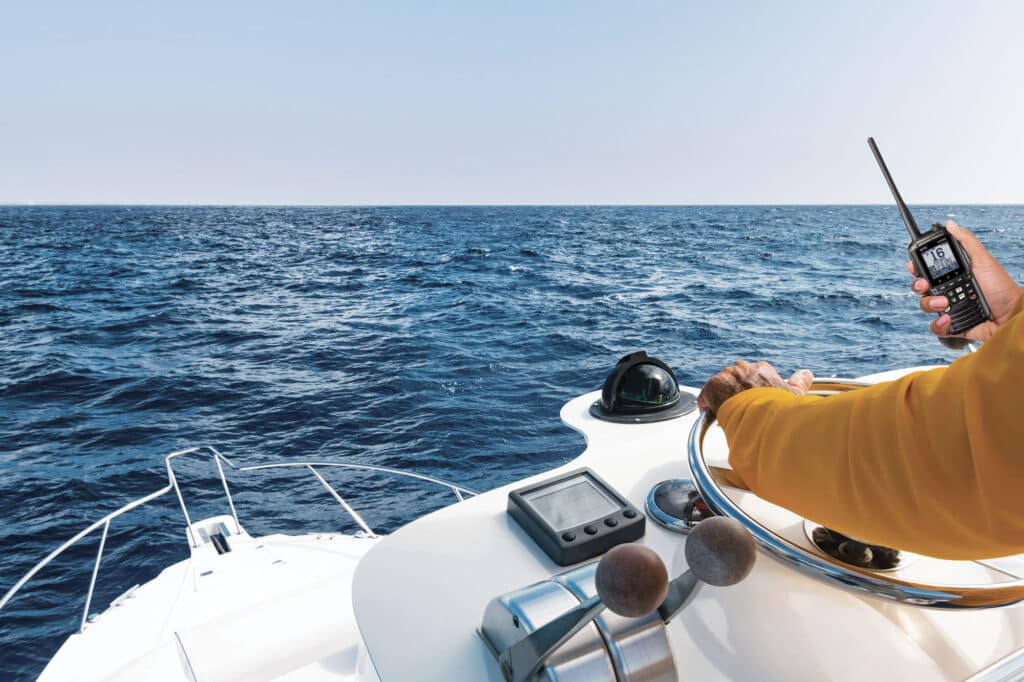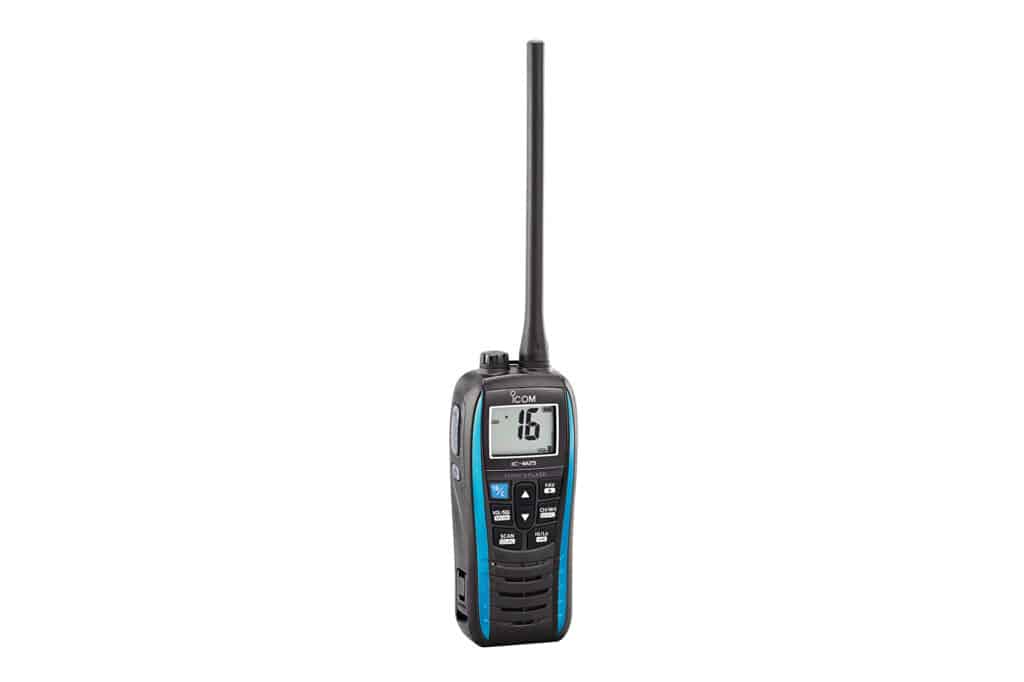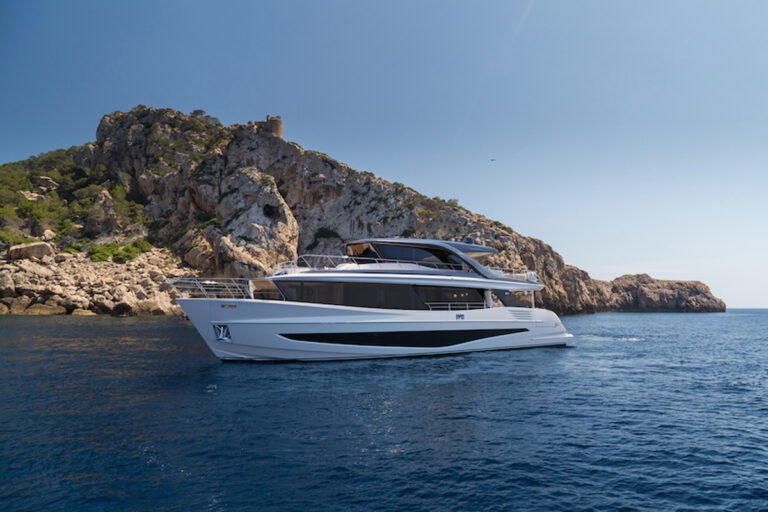
My friend recently posited that if forced to choose, he’d rather lose his wallet than his iPhone.
After pondering, I had to agree. Communication is key everywhere, and, at least ashore, the smartphone has become the most important nexus of modern culture’s holy trinity (wallet, phone, keys).
On board, however, the argument changes, especially when cruising outside of cellular coverage. At that point, the VHF radio and its ability to communicate with multiple nearby vessels and shore stations juggernauts its technology to the top of the importance pyramid. While there’s no question that a fixed-mount VHF radio is a must-have for every helm, few electronic tools are a better universal fit than a reliable and fully featured handheld.
Marine-band VHF communications arrived in the 1950s, giving mariners the ability to talk, either ship-to-ship or ship-to-shore, over line-of-sight distances using radio-frequency transmissions. The first VHF radios were fixed-mount systems. As technology improved and demand grew, handhelds arrived. Recent years have seen new features, such as embedded automatic identification system, digital selective calling and GPS receivers.
Marine VHF is a tightly regulated technology; in the United States, it’s overseen by the Federal Communications Commission. Fixed-mount systems are limited to 25 watts of transmitting power, and handhelds to 6 watts. Depending on how they’re spec’d, marine VHF radios can use more than 40 channels that fall between 156.050 and 157.425 megahertz, and 161.6 and 162.550 MHz. As with all RF communications, transmitting power and antenna height equate to greater range.

The comparatively simple handhelds of the 1990s allowed for voice communications over distances of about 3 to 5 nautical miles. Their rechargeable nickel-cadmium batteries delivered good performance for the era, but they were prone to discharging if they were left unused. Worse, they could develop chemical memories that made recharging complicated. Screens were small and tough to read in direct sunlight, and user interfaces involved hard, tactile keys, dedicated volume knobs and awkward software.
Today, while the frequencies and power outputs are unchanged, modern handhelds are far more sophisticated than even a decade ago. Integration has been key. Higher-end handhelds now have built-in DSC, GPS and AIS receivers.
“DSC is the biggest advancement,” says Hans Rooker, Standard Horizon’s national sales manager. “It delivers the capability of position-sharing, poling and distress-calling.”
Provided that owners properly register for—and program—their nine-digit identification number (called a maritime mobile service identity), all receiving parties can ascertain information that’s valuable and possibly lifesaving. “The combination of the DSC and GPS tells first responders like the Coast Guard vital information on who you are, what type of boat and where you are located,” says Ray Novak, Icom America’s senior sales manager.
DSC also has nonemergency features, most notably the ability to create buddy lists and directly call friends via their MMSI. Provided that the vessels are in range, this technique often saves time and allows users to treat their radios much like they do their smartphones ashore.
While fixed-mount radios have long sported AIS (listen-only receivers as well as listen-and-transmit transceivers), Icom’s flagship M94D is the first and only handheld to offer a built-in AIS receiver. AIS data is shown on the handheld’s display, atop a simplified navigation system. This adds a new level of functionality in handhelds, Novak says: “Not only can you see AIS traffic around you; you can make direct calls to vessels in the area, if there is an issue.”
AIS also lets users set up proximity alerts and receive notifications, if other vessels with AIS transceivers enter their designated watch area.
One of the biggest pitfalls involving DSC and AIS transceivers and fixed-mount VHF radios occurs when users fail to properly network their vessel’s GPS with their radio. “Seventy-six percent of the unanswered DSC calls are due to no GPS coordinates being transmitted,” Novak says. While handhelds don’t have the same punch as fixed-mount versions, one inherent advantage of all AIS- and DSC-enabled handhelds—and their hard-wired GPS receivers—is that they’re self-contained, so all AIS or DSC transmissions always include real-time GPS information.
It might seem obvious in hindsight, but the first floating handheld (Icom’s M34) didn’t arrive until 2007. Today, all reputable handhelds float (some face-up) and offer some water-ingress protection. Many contemporary radios also have a water-activated light or strobe that simplifies retrieval missions, and most have a water-shedding feature to protect their speakers. Other newer features include voice scramblers for making private calls, and scanning features that can monitor multiple channels for incoming RF waves.
Today’s flagship handhelds—Icom’s M94D and Standard Horizon’s HX890—have large backlit screens and intuitive user interfaces. Today’s budget-conscious radios also have easy-to-read displays and intuitive software, even if the tactile buttons have yet to be replaced by touchscreens.
As with all electronics, most handhelds now also employ compact, lightweight lithium-ion batteries that recharge quickly, sans memory issues.
And in terms of pricing, the difference in cost between high-end and entry-level offerings is minimal, especially compared with the electronics normally discussed in these pages. Case in point: Standard Horizon’s entry-level HX210 costs $100, while its top-of-the-line HX890 fetches $200. Icom’s M94D, at $350, is the outlier, but the added benefits of AIS can justify its costs.
Given the features of today’s handhelds relative to their affordability, there’s zero reason to cling to an old clunker. Size is a fair argument, especially for portable electronics, and the flagship handhelds from Standard Horizon and Icom are admittedly bigger (especially the M94D) than pared-down offerings. That said, most good foul-weather jackets have large pockets for a reason.
So, while I don’t plan to deep-six any member of my holy trinity anytime soon, a lifetime of sailing has demonstrated the value of my trusty handheld VHF radio, especially as that last bar of cellular connectivity vanishes.
There’s an App for That
While today’s economies of scale (or lack thereof) discourage manufacturers from innovating touchscreen-driven handheld VHF radios, owners of Icom’s fixed-mount IC-M510 radio can turn their smartphone into a wireless CommandMic via Icom’s free RS-M500 app. It lets smartphones broadcast at 25 watts and leverage the yacht’s main VHF antenna too.









